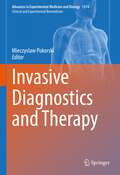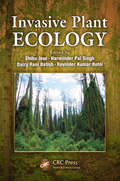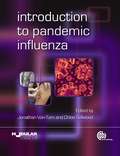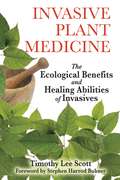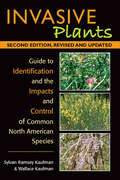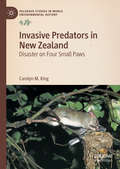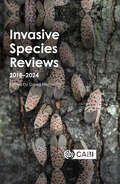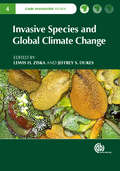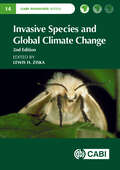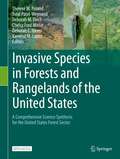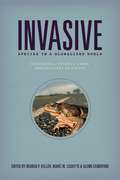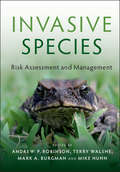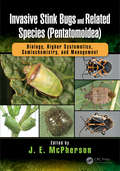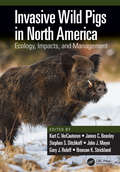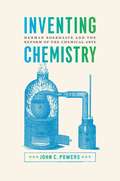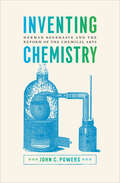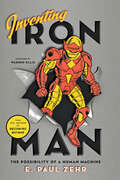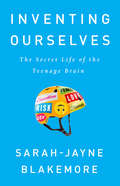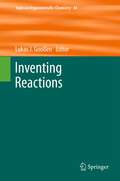- Table View
- List View
Invasive Diagnostics and Therapy (Advances in Experimental Medicine and Biology #1374)
by Mieczyslaw PokorskiThe book is an update on contentious or unsettled issues concerning invasive diagnostic and therapeutic challenges in cancer and related disorders, focusing on the surgical approach. Topics include recommendations for the best practice in using the surgery safety checklist, surgical strategies in a variety of thoracic cancers, renal cell carcinoma, tumors of parathyroid glands, mesothelioma, and bariatric surgeries. The focus is on the diagnostic and therapeutic challenges of aggressive cancerous entities, choosing the most beneficial modes for optimal outcomes and patient survival. Chapters also address radioimaging and therapy outcomes in different intracranial lesions leading to severe neurological disabilities. The areas of medical practice addressed are still veiled in uncertainty, yet-unresolved pathogenetic background, and have a substantial component of empirical rather than evidence-based clinical approach. Pursuing and sharing new ideas and innovations is essential for improving the management and outcome. The book endeavors to disseminate and deliberate on the latest medical knowledge, studies, and advancements in surgical and diagnostic dealing with cancer. The book is addressed to physicians and surgeons, and all allied health care professionals engaged in patient care and therapy.
Invasive Plant Ecology
by Shibu Jose Ravinder Kumar Kohli Harminder Pal Singh Daizy Rani BatishInvasion of non-native plant species, which has a significant impact on the earth's ecosystems, has greatly increased in recent years due to expanding trade and transport among different countries. Understanding the ecological principles underlying the invasive process as well as the characteristics of the invasive plants is crucial for making good
Invasive Plant Ecology in Natural and Agricultural Systems
by Stephen Murphy Clarence Swanton Barbara BoothBringing together reasons for why and where weeds occur and the ecological importance of weed management, this updated edition (previously entitled "Weed Ecology") provides an in-depth study of plant ecology with greater coverage of invasive plant biology and more concise statistics. In a new, larger format, printed in two colours, and illustrated throughout with figures, tables and case studies it is an essential text for students in plant ecology, agriculture and horticulture.
Invasive Plant Medicine: The Ecological Benefits and Healing Abilities of Invasives
by Stephen Harrod Buhner Timothy Lee ScottThe first book to demonstrate how plants originally considered harmful to the environment actually restore Earth’s ecosystems and possess powerful healing properties • Explains how invasive plants enhance biodiversity, purify ecosystems, and revitalize the land • Provides a detailed look at the healing properties of 25 of the most common invasive plants Most of the invasive plant species under attack for disruption of local ecosystems in the United States are from Asia, where they play an important role in traditional healing. In opposition to the loud chorus of those clamoring for the eradication of all these plants that, to the casual observer, appear to be a threat to native flora, Timothy Scott shows how these opportunistic plants are restoring health to Earth’s ecosystems. Far less a threat to the environment than the cocktails of toxic pesticides used to control them, these invasive plants perform an essential ecological function that serves to heal both the land on which they grow and the human beings who live upon it. These plants remove toxic residues in the soil, providing detoxification properties that can help heal individuals. Invasive Plant Medicine demonstrates how these “invasives” restore natural balance and biodiversity to the environment and examines the powerful healing properties offered by 25 of the most common invasive plants growing in North America and Europe. Each plant examined includes a detailed description of its physiological actions and uses in traditional healing practices; tips on harvesting, preparation, and dosage; contraindications; and any possible side effects. This is the first book to explore invasive plants not only for their profound medical benefits but also with a deep ecological perspective that reveals how plant intelligence allows them to flourish wherever they grow.
Invasive Plants and Forest Ecosystems
by Shibu Jose Ravinder Kumar Kohli Harminder Pal Singh Daizy Rani BatishAs the worldwide human population explodes and trade becomes increasingly globalized, the transboundary movement of plant species from their place of origin to foreign regions is escalating and expected to experience continued growth in the coming decades. Invasive non-native species pose one of the greatest challenges for natural resource managers who are charged with the maintenance of biological diversity and the sustainable production of forest resources. With international contributors presenting an informed and integrated approach to the control of havoc-wrecking species, Invasive Plants and Forest Ecosystems provides the most updated information on invading plants, their impacts on forest ecosystems, and control strategies. This text addresses such important issues as the socioeconomic and policy aspects of plant invasion and offers complete coverage of their ecological impacts and the varied levels of threats in diverse situations.
Invasive Plants: Guide to Identification and the Impacts and Control of Common North American Species
by Wallace Kaufman Sylvan Ramsey KaufmanNewly updated: &“Invasive plants are ecological tumors that degrade food webs wherever they go. The third edition of [this book] is an invaluable reference.&” —Douglas Tallamy, New York Times–bestselling author of Nature&’s Best Hope This easy-to-use, wide-ranging guide to invasive plants in North America features full-color photos and descriptions of more than 250 alien species—both terrestrial and aquatic—that are in some cases changing the landscape to an almost unimaginable degree. Accompanying text describes the plant&’s environmental and economic impacts as well as management techniques used to control it. Also included is an explanation of what an invasive is and a step-by-step identification key. Used by U.S. Forest Service botanists, this is an essential guide to understanding this unprecedented environmental challenge that is threatening biodiversity—and the human population that depends on it to survive. &“A colorful, general field guide to the major invasive plants of North America…packed with relevant information.&” —Great Plains Research: A Journal of Natural and Social Sciences &“A wonderful guide.&” —The Roanoke Star
Invasive Predators in New Zealand: Disaster on Four Small Paws (Palgrave Studies in World Environmental History)
by Carolyn M. KingThe story of invasive species in New Zealand is unlike any other in the world. By the mid-thirteenth century, the main islands of the country were the last large landmasses on Earth to remain uninhabited by humans, or any other land mammals. New Zealand’s endemic fauna evolved in isolation until first Polynesians, and then Europeans, arrived with a host of companion animals such as rats and cats in tow. Well-equipped with teeth and claws, these small furry mammals, along with the later arrival of stoats and ferrets, have devastated the fragile populations of unique birds, lizards and insects. Carolyn M. King brings together the necessary historical analysis and recent ecological research to understand this long, slow tragedy. As a comprehensive historical perspective on the fate of an iconic endemic fauna, this book offers much-needed insight into one of New Zealand’s longest-running national crises.
Invasive Species Reviews: 2018-2024
by David HemmingInvasive species are responsible for significant impacts on agriculture, food security and health worldwide. This collection looks at a wide range of invasive species, including insects, plants, snails, fungal diseases, including: Mimosa diplotricha, Chromolaena odorata, privet, Opuntia, fall armyworm, Aedes albopictus, Prostephanus truncatus, Pomacea, and ash dieback. The articles examine mechanisms for detecting the spread of invasive species, and models for understanding the mechanisms of invasion alongside control and management approaches with a particular focus on biological control. The articles have been specially selected from contributions to CABI Reviews.
Invasive Species and Global Climate Change
by John Thompson Andrew Guitierrez Arne Witt Randy Westbrooks Elsa Cleland Lewis Ziska Cascade Sorte Matthew Barnes Toni Ditommaso Bethany Bradley Dana Blumenthal Jeffery Dukes Hilda Diaz-Soltero Jacques Regniere Karen Garrett Li Bo Jil Swearingen Kevin Hughes Makra Laszlo Tom StohlgrenThis book examines what will happen to global invasive species, including plants, animals and pathogens with current and expected man-made climate change. The effects on distribution, success, spread and impact of invasive species are considered for a series of case studies from a number of countries. This book will be of great value to researchers, policymakers and industry in responding to changing management needs.
Invasive Species and Global Climate Change (CABI Invasives Series)
by John Thompson Andrew Guitierrez Arne Witt Randy Westbrooks Elsa Cleland Cascade Sorte Matthew Barnes Bethany Bradley Dana Blumenthal Hilda Diaz-Soltero Jacques Regniere Karen Garrett Li Bo Jil Swearingen Kevin Hughes Makra Laszlo Tom Stohlgren Toni DiTommasoThis book examines what will happen to global invasive species, including plants, animals and pathogens with current and expected man-made climate change. The effects on distribution, success, spread and impact of invasive species are considered for a series of case studies from a number of countries. This book will be of great value to researchers, policymakers and industry in responding to changing management needs.
Invasive Species and Global Climate Change (CABI Invasives Series)
by Lewis H. ZiskaThis book addresses topics related to the impact of invasive species including biosecurity, demographics, species diversity and food security. It is meant for researchers, upper-level students, and policy makers and provides a factual basis for the underlying science and a discussion of that information with respect to current and future impacts and possible solutions. This book explores the nexus of climate change and biological invasions, resulting impacts (biological and economic) and assesses ways to reduce vulnerability and increase the resiliency and sustainability of managed and unmanaged ecosystems. The book has three parts, focusing on: (1) the dimensions of the problem; background and science; (2) case studies; (3) Management: detection, prevention, control and adaptation. This revised edition examines a wide range of topics and region, the underlying science, examples (case studies) from around the world, and ways and means to recognize, manage and control the consequences. It includes new cases and new threats; for example, a chapter summarizing case studies regarding climate change and invasive species that are also disease carriers (e.g. ticks and Lyme disease). - Covers a wide range of topics and areas - Examines the synergy between invasive species and climate change - Explains options to control and mitigate effects This book is of interest to academics, researchers and students studying climate change and invasive species. Those interested in the environment and ecology, land managers, policy makers, agronomists, federal and state departments of natural resources, climate change activists, public health professionals.
Invasive Species in Forests and Rangelands of the United States: A Comprehensive Science Synthesis for the United States Forest Sector
by Toral Patel-Weynand Vanessa M. Lopez Deborah C. Hayes Therese M. Poland Deborah M. Finch Chelcy Ford MiniatThis open access book describes the serious threat of invasive species to native ecosystems. Invasive species have caused and will continue to cause enormous ecological and economic damage with ever increasing world trade. This multi-disciplinary book, written by over 100 national experts, presents the latest research on a wide range of natural science and social science fields that explore the ecology, impacts, and practical tools for management of invasive species. It covers species of all taxonomic groups from insects and pathogens, to plants, vertebrates, and aquatic organisms that impact a diversity of habitats in forests, rangelands and grasslands of the United States. It is well-illustrated, provides summaries of the most important invasive species and issues impacting all regions of the country, and includes a comprehensive primary reference list for each topic. This scientific synthesis provides the cultural, economic, scientific and social context for addressing environmental challenges posed by invasive species and will be a valuable resource for scholars, policy makers, natural resource managers and practitioners.
Invasive Species in a Globalized World: Ecological, Social, & Legal Perspectives on Policy
by Reuben P. Keller, Marc W. Cadotte, Glenn SandifordOver the past several decades, the field of invasion biology has rapidly expanded as global trade and the spread of human populations have increasingly carried animal and plant species across natural barriers that have kept them ecologically separated for millions of years. Because some of these nonnative species thrive in their new homes and harm environments, economies, and human health, the prevention and management of invasive species has become a major policy goal from local to international levels. Yet even though ecological research has led to public conversation and policy recommendations, those recommendations have frequently been ignored, and the efforts to counter invasive species have been largely unsuccessful. Recognizing the need to engage experts across the life, social, and legal sciences as well as the humanities, the editors of this volume have drawn together a wide variety of ecologists, historians, economists, legal scholars, policy makers, and communications scholars, to facilitate a dialogue among these disciplines and understand fully the invasive species phenomenon. Aided by case studies of well-known invasives such as the cane toad of Australia and the emerald ash borer, Asian carp, and sea lampreys that threaten US ecosystems, Invasive Species in a Globalized World offers strategies for developing and implementing anti-invasive policies designed to stop their introduction and spread, and to limit their effects.
Invasive Species: Risk Assessment and Management
by Mark A. Robinson Andrew P. Terry Walshe Burgman Mike NunnBiological invasions are one of the strongest drivers of global environmental change, and invasive species are now often in the public discourse. At the same time, economists have begun to take a real interest in determining how invasive species interact with economic systems, and how invaders should be controlled to optimize societal wealth. Although the work from ecologists and economists have both greatly expanded our understanding of the drivers and impacts of invasions, little integration between the fields has occurred that would allow managers and policy-makers to identify the optical expenditures on, for example, prevention and control of invasive species. Because the level of effort expended on invasive species management is intricately linked to the costs and projected benefits of that management, there is an urgent need for greater synthesis between ecology and economics. This book brings ecology and economics together in new ways to address how we deal with the dynamics and impacts of invasive species, and is the outcome fo many years of collaborative research between a small group of economists and ecologists. The outcome is clear demonstration of the utility of combining ecological and economic models for addressing critical questions in the management of invasive species.
Invasive Species: Vectors and Management Strategies
by Gregory M. Ruiz James CarltonInvasive Species brings together in a single volume new information from leading scientists around the world on approaches to controlling and managing invasion vectors. This volume is a timely and essential reference for scientists, researchers, policymakers, and anyone concerned with understanding biological invasions and developing effective responses to them.
Invasive Stink Bugs and Related Species: Biology, Higher Systematics, Semiochemistry, and Management (Contemporary Topics in Entomology)
by J. E. McPhersonKey features: Presents a brief history of past classifications, a summary of present classification, and speculation on how the classification may evolve in the future Includes keys for the identification of families and subfamilies of the Pentatomoidea and for the tribes in the Pentatomidae Explains transmission of plant pathogens and concepts of pathology and heteropteran feeding for the non-specialist Provides an extensive literature review of transmission by stink bugs of viral, bacterial, fungal, and protozoan organisms that cause diseases of plants Discusses the diversity of microbial symbionts in the Pentatomidae and related species, showing how microorganisms underpin the evolution of this insect group Reviews semiochemicals (pheromones, kairomones, allomones) of the Pentatomoidea and their vital role in the life histories of pest and beneficial species and their exploitation by natural enemies of true bugs Covers past, current, and future control options for insects, with a focus on stink bugs and related heteropterans The Superfamily Pentatomoidea (stink bugs and their relatives) is comprised of 18 families with over 8,000 species, the largest of which is the family Pentatomidae (about 5,000 species). These species primarily are phytophagous, and many cause tremendous economic damage to crops worldwide. Within this superfamily are six invasive species, two that occur worldwide and four that are recent invaders in North America. Once established in new geographic regions, these species have increased their numbers and geographic distributions dramatically, causing economic damage totaling billions of dollars. Invasive Stink Bugs and Related Species (Pentatomoidea): Biology, Higher Systematics, Semiochemistry, and Management is the first book that presents comprehensive coverage of the biology of invasive pentatomoids and related true bug species and addresses issues of rapidly growing economic and environmental concerns. Containing the contributions of more than 60 stink bug specialists from 15 countries, this book provides a better understanding of the biology and economic importance of these invasive species, why they became invasive, and how their continued geographical expansion is likely to affect numerous agricultural systems and natural environments. Including over 3,500 references, this authoritative work serves as an access point to the primary literature on their life histories, higher systematics, diapause and seasonal cycles, pathogens, symbionts, semiochemistry, and pest management control strategies for pentatomoid bugs.
Invasive Wild Pigs in North America: Ecology, Impacts, and Management
by Kurt C. VerCauteren James C. Beasley Stephen S. Ditchkoff John J. Mayer Gary J. Roloff Bronson K. StricklandThroughout North America, non-native wild pigs have become an ecologically and economically destructive invasive species. Though they are regarded as a popular game species by some, provide economic benefits to others, and are even engrained into societal heritage in some areas, wild pigs are responsible for an extraordinary amount of damage in both natural and anthropogenic systems throughout North America. As the density and range of wild pig habitat have substantially increased over the last several decades, the magnitude and diversity of their negative impacts are not yet fully realized or quantified. With various conflicts continually emerging, wild pig management is difficult and expensive to achieve. As a result, wild pigs represent one of the greatest wildlife management challenges North America faces in the 21st century. Invasive Wild Pigs in North America: Ecology, Impacts, and Management addresses all aspects of wild pig biology, ecology, damage, and management in a single comprehensive volume. It assimilates and organizes information on the most destructive introduced vertebrate species in the United States, establishing a foundation from which managers, researchers, policy makers, and other stakeholders can build upon into the future. The book provides comprehensive coverage of wild pig biology and ecology, techniques for management and research, and regional chapters. It is an asset to readers interested in wild pigs, the resources they impact, and how to mitigate those impacts, and establishes a vision of the future of wild pigs in North America. Features: Compiles valuable knowledge for a broad audience including wild pig managers, researchers, adversaries, and enthusiasts from across North America Addresses taxonomy, morphology, genetics, physiology, spatial ecology, population dynamics, diseases and parasites, and the naturalized niche of wild pigs Includes chapters on damage to resources, management, research methods, human dimensions and education, and policy and legislation Contains full color images and case studies of interesting and informative situations being created by wild pigs throughout North America Includes a chapter on wild pigs at the wildland–urban interface, a more recent and especially challenging issue
Invasive and Introduced Plants and Animals: Human Perceptions, Attitudes and Approaches to Management
by Ian D. Rotherham Robert A. LambertThere have been many well-publicized cases of invasive species of plants and animals, often introduced unintentionally but sometimes on purpose, causing widespread ecological havoc. Examples of such alien invasions include pernicious weeds such as Japanese knotweed, an introduced garden ornamental which can grow through concrete, the water hyacinth which has choked tropical waterways, and many introduced animals which have out-competed and displaced local fauna. This book addresses the broader context of invasive and exotic species, in terms of the perceived threats and environmental concerns which surround alien species and ecological invasions. As a result of unprecedented scales of environmental change, combined with rapid globalisation, the mixing of cultures and diversity, and fears over biosecurity and bioterrorism, the known impacts of particular invasions have been catastrophic. However, as several chapters show, reactions to some exotic species, and the justifications for interventions in certain situations, including biological control by introduced natural enemies, rest uncomfortably with social reactions to ethnic cleansing and persecution perpetrated across the globe. The role of democracy in deciding and determining environmental policy is another emerging issue. In an increasingly multicultural society this raises huge questions of ethics and choice. At the same time, in order to redress major ecological losses, the science of reintroduction of native species has also come to the fore, and is widely accepted by many in nature conservation. However, with questions of where and when, and with what species or even species analogues, reintroductions are acceptable, the topic is hotly debated. Again, it is shown that many decisions are based on values and perceptions rather than objective science. Including a wide range of case studies from around the world, his book raises critical issues to stimulate a much wider debate.
Invasomes as Drug Nanocarriers for Innovative Pharmaceutical Dosage Forms
by Nina DragićevićThis book details the novel nanocarriers named 'invasomes" and how they are used for dermal and transdermal drug delivery. The text describes their composition, usage of skin as a drug delivery route and liposomes as skin delivery systems. Included are reviewed studies revealing the importance of invasomes in this field.
Inventing Atmospheric Science: Bjerknes, Rossby, Wexler, and the Foundations of Modern Meteorology
by James Rodger FlemingHow scientists used transformative new technologies to understand the complexities of weather and the atmosphere, told through the intertwined careers of three key figures.“The goal of meteorology is to portray everything atmospheric, everywhere, always,” declared John Bellamy and Harry Wexler in 1960, soon after the successful launch of TIROS 1, the first weather satellite. Throughout the twentieth century, meteorological researchers have had global ambitions, incorporating technological advances into their scientific study as they worked to link theory with practice. Wireless telegraphy, radio, aviation, nuclear tracers, rockets, digital computers, and Earth-orbiting satellites opened up entirely new research horizons for meteorologists. In this book, James Fleming charts the emergence of the interdisciplinary field of atmospheric science through the lives and careers of three key figures: Vilhelm Bjerknes (1862–1951), Carl-Gustaf Rossby (1898–1957), and Harry Wexler (1911–1962).In the early twentieth century, Bjerknes worked to put meteorology on solid observational and theoretical foundations. His younger colleague, the innovative and influential Rossby, built the first graduate program in meteorology (at MIT), trained aviation cadets during World War II, and was a pioneer in numerical weather prediction and atmospheric chemistry. Wexler, one of Rossby's best students, became head of research at the U.S. Weather Bureau, where he developed new technologies from radar and rockets to computers and satellites, conducted research on the Antarctic ice sheet, and established carbon dioxide measurements at the Mauna Loa Observatory in Hawaii. He was also the first meteorologist to fly into a hurricane—an experience he chose never to repeat.Fleming maps both the ambitions of an evolving field and the constraints that checked them—war, bureaucracy, economic downturns, and, most important, the ultimate realization (prompted by the formulation of chaos theory in the 1960s by Edward Lorenz) that perfectly accurate measurements and forecasts would never be possible.
Inventing Chemistry: Herman Boerhaave and the Reform of the Chemical Arts
by John C. PowersIn Inventing Chemistry, historian John C. Powers turns his attention to Herman Boerhaave (1668-1738), a Dutch medical and chemical professor whose work reached a wide, educated audience and became the template for chemical knowledge in the eighteenth century. The primary focus of this study is Boerhaave's educational philosophy, and Powers traces its development from Boerhaave's early days as a student in Leiden through his publication of the Elementa chemiae in 1732. Powers reveals how Boerhaave restructured and reinterpreted various practices from diverse chemical traditions (including craft chemistry, Paracelsian medical chemistry, and alchemy), shaping them into a chemical course that conformed to the pedagogical and philosophical norms of Leiden University's medical faculty. In doing so, Boerhaave gave his chemistry a coherent organizational structure and philosophical foundation and thus transformed an artisanal practice into an academic discipline. Inventing Chemistry is essential reading for historians of chemistry, medicine, and academic life.
Inventing Chemistry: Herman Boerhaave and the Reform of the Chemical Arts (Synthesis)
by John C. PowersThe story of this little-known Dutch physician &“will interest students and practitioners of history, chemistry, and philosophy of science&” (Choice). In Inventing Chemistry, historian John C. Powers turns his attention to Herman Boerhaave (1668–1738), a Dutch medical and chemical professor whose work reached a wide, educated audience and became the template for chemical knowledge in the eighteenth century. The primary focus of this study is Boerhaave&’s educational philosophy, and Powers traces its development from Boerhaave&’s early days as a student in Leiden through his publication of the Elementa chemiae in 1732. Powers reveals how Boerhaave restructured and reinterpreted various practices from diverse chemical traditions (including craft chemistry, Paracelsian medical chemistry, and alchemy), shaping them into a chemical course that conformed to the pedagogical and philosophical norms of Leiden University&’s medical faculty. In doing so, Boerhaave gave his chemistry a coherent organizational structure and philosophical foundation, and thus transformed an artisanal practice into an academic discipline. Inventing Chemistry is essential reading for historians of chemistry, medicine, and academic life.
Inventing Iron Man: The Possibility of a Human Machine
by E. Paul ZehrTony Stark has been battling bad guys and protecting innocent civilians since he first donned his mechanized armor in the 1963 debut of Iron Man in Marvel Comics. Over the years, Stark’s suit has allowed him to smash through walls, fly through the air like a human jet, control a bewildering array of weaponry by thought alone, and perform an uncountable number of other fantastic feats. The man who showed us all what it would take to become Batman probes whether science—and humankind—is up to the task of inventing a real-life Iron Man.E. Paul Zehr physically deconstructs Iron Man to find out how we could use modern-day technology to create a suit of armor similar to the one Stark made. Applying scientific principles and an incredibly creative mind to the question, Zehr looks at how Iron Man’s suit allows Stark to become a superhero. He discusses the mind-boggling and body-straining feats Iron Man performed to defeat villains like Crimson Dynamo, Iron Monger, and Whiplash and how such acts would play out in the real world. Zehr finds that science is nearing the point where a suit like Iron Man’s could be made. But superherodom is not just about technology. Zehr also discusses our own physical limitations and asks whether an extremely well-conditioned person could use Iron Man’s armor and do what he does.A scientifically sound look at brain-machine interfaces and the outer limits where neuroscience and neural plasticity meet, Inventing Iron Man is a fun comparison between comic book science fiction and modern science. If you’ve ever wondered whether you have what it takes to be the ultimate human-machine hero, then this book is for you.
Inventing Ourselves: The Secret Life of the Teenage Brain
by Sarah-Jayne BlakemoreA tour through the groundbreaking science behind the enigmatic, but crucial, brain developments of adolescence and how those translate into teenage behaviorThe brain creates every feeling, emotion, and desire we experience, and stores every one of our memories. And yet, until very recently, scientists believed our brains were fully developed from childhood on. Now, thanks to imaging technology that enables us to look inside the living human brain at all ages, we know that this isn't so. Professor Sarah-Jayne Blakemore, one of the world's leading researchers into adolescent neurology, explains precisely what is going on in the complex and fascinating brains of teenagers--namely that the brain goes on developing and changing right through adolescence--with profound implications for the adults these young people will become.Drawing from cutting-edge research, including her own, Blakemore shows:How an adolescent brain differs from those of children and adultsWhy problem-free kids can turn into challenging teensWhat drives the excessive risk-taking and all-consuming relationships common among teenagersAnd why many mental illnesses--depression, addiction, schizophrenia--present during these formative yearsBlakemore's discoveries have transformed our understanding of the teenage mind, with consequences for law, education policy and practice, and, most of all, parents.
Inventing Reactions
by Lukas J. GooßenBarry Trost: Transition metal catalyzed allylic alkylation.- Jeffrey W. Bode: Reinventing Amide Bond Formation.- Naoto Chatani and Mamoru Tobisu: Catalytic Transformations Involving the Cleavage of C-OMe Bonds.- Gregory L. Beutner and Scott E. Denmark: The Interplay of Invention, Observation and Discovery in the Development of Lewis Base Activation of Lewis Acids for Catalytic Enantioselective Synthesis.- David R. Stuart and Keith Fagnou: The Discovery and Development of a Palladium(II)-Catalyzed Oxidative Cross-Coupling of Two Unactivated Arenes.- Lukas Gooßen and Käthe Gooßen: Decarboxylative Cross-Coupling Reactions.- A. Stephen K. Hashmi: Gold-Catalyzed Organic Reactions.- Ben List: Developing Catalytic Asymmetric Acetalizations.- Steven M. Bischof, Brian G. Hashiguchi, Michael M. Konnick, and Roy A. Periana: The De NovoDesign of CH Bond Hydroxylation Catalysts.- Benoit Cardinal-David, Karl A. Scheidt: Carbene Catalysis: Beyond the Benzoin and Stetter Reactions.- Kenso Soai and Tsuneomi Kawasaki: Asymmetric autocatalysis of pyrimidyl alkanol.- Douglas C. Behenna and Brian M. Stoltz: Natural Products as Inspiration for Reaction Development: Catalytic Enantioselective Decarboxylative Reactions of Prochiral Enolate Equivalents. Hisashi Yamamoto: Acid Catalysis in Organic Synthesis.
